
















































With access to 60–80 per cent mortgage lending, and interest-only loans, it is no surprise so many South Africans are investing in property in the United Kingdom, writes
SOPHIE GAMBORG, property specialist at LIO Global International Property Collection
Recently, I was listening to a talk by the CEO of a well-known tax and retirement planning company in South Africa; he made a comment I had not heard before, but will not forget: “Live in the sun but invest in the shade”.
He said most of his African clients invest some of their money overseas in hard currencies. He briefly mentioned the political climate of South Africa, the security, load shedding, and volatility of the currency, and that his clients felt more confi dent once they had taken some of their funds out of South Africa.
investment assets. The good news is there has been a drop in UK mortgage rates, which are now set to remain between four and five per cent in 2023, having been around six per cent at the end of 2022.
A South African looking to invest money offshore would benefit from this interest rate drop and the soaring demand of the UK rental market. The Telegraph reports that rents have risen 8.3 per cent in the year to January, and a statement from Knight Frank read, “this is the best rental market we have seen in years in terms of price and demand”.
that as a South African you can get a UK interest-only mortgage of up to 80 per cent.
Having moved recently to South Africa and seeing all it has to offer, I found this discussion a little negative. However, it made sense that his clients would want to do this, especially now that the Rand is at 22 to the British pound. If South Africans can take the Rand and invest overseas, they can make their money work harder and ultimately achieve greater global independence.
The United Kingdom (UK) property market has always maintained strong stability and resilience, despite the many challenges it has faced.
In the past 50 years, the property market has had 43 years of positive growth, so it is not surprising it is one of the most popular
For South Africans who love the idea of investing offshore and creating an income in a hard currency, perhaps now is the time to invest. South Africans can borrow from UK banks and benefit from an interest-only mortgage, meaning that, in most cases, their rental income will pay the mortgage. This way, they can start building an income in UK sterling, while their property grows in value.
Currently, the top three performing UK markets in terms of price growth are:
• Nottinghamshire (+9%);
• Birmingham (+8.1%); and
• Manchester (+8.1%).
In 2021, Newark, a historic town in Nottinghamshire, saw a 20% increase in house prices, making it the second best performing market in the whole of the UK in terms of house price growth. It is no wonder that three of LIO International’s clients invested in Nottinghamshire last week, and one of its Birmingham projects sold out within two months from launch.
One of our latest projects in Manchester, a seven-minute walk from Manchester Piccadilly
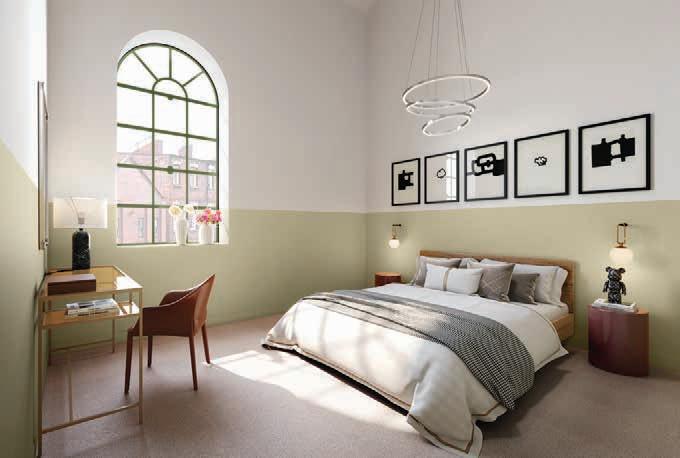

(the train line going direct to London) offers seven per cent rental yields, more than double the UK average. House price growth in Manchester is anticipated to increase 19.3 per cent by 2027. Given these statistics, it is understandable why so many property investors worldwide choose to invest in the UK market.
Our team has over 15 years of international property experience, and we love what we do. Our focus is not on making an individual sale, but on helping our clients build an international property portfolio. We seek to build generational wealth through smart property investment choices.
Scan this QR code to go directly to the LIO GLOBAL website.


PUBLISHED BY
Picasso Headline, A proud division of Arena Holdings (Pty) Ltd, Hill on Empire, 16 Empire Road (cnr Hillside Road), Parktown, Johannesburg, 2193 PO Box 12500, Mill Street, Cape Town, 8010 www.businessmediamags.co.za
EDITORIAL
Content Manager: Raina Julies rainaj@picasso.co.za
Contributors: Tennille Belle, Trevor Crighton, Caryn Gootkin, Gareth Griffiths, Cobus Odendaal, Shane Padayachy, Tiisetso Tlelima
Copy Editor: Brenda Bryden
Content Co-ordinator: Vanessa Payne
DESIGN
Head of Design: Jayne Macé-Ferguson
Senior Design: Mfundo Archie Ndzo
Advert Designer: Bulelwa Sotashe
Cover Image: Courtesy: Paragon Interface
SALES
Project Manager: Merryl Klein merrylk@picasso.co.za | +27 21 469 2446
PRODUCTION
Production Editor: Shamiela Brenner
Advertising Co-ordinator: Fatima Dramat
Subscriptions and Distribution: Fatima Dramat fatimad@picasso.co.za
Printer: CTP Printers, Cape Town
MANAGEMENT
Management Accountant: Deidre Musha
Business Manager: Lodewyk van der Walt
General Manager, Magazines: Jocelyne Bayer
4

The office accommodation of today requires innovation and planning if an employer is to get and stay ahead. So, what keeps employees and corporate tenants happy?
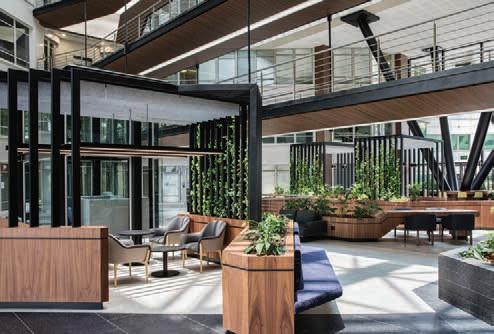
9 PROPERTY INVESTMENT AND MANAGEMENT
Understanding the role of asset management; Embracing technology is key to remaining effective and efficient in the property management industry; Unpacking the disruptive trends shaping the commercial offshore and sub-Saharan investment markets; What makes the United Kingdom and Poland attractive markets for South African commercial property developers?
13 THOUGHT LEADERSHIP – FINANCE
What every small business owner needs to know about securing financing for commercial property.
EDITORIAL
14 LOGISTICS AND WAREHOUSING
What is driving the Western Cape’s high level of activity and interest for warehousing space?; Why refreshing your warehouse management system before it becomes an e-commerce nightmare is critical.


17 MIXED-USE DEVELOPMENT
Why the demand for convenient mixed-use living is still a popular alternative for those wanting to live and work without long commutes.
19 RETAIL
We unpack how the retail sector is expanding its value proposition to customers via innovations in a post-pandemic environment.
18 HOSPITALITY
The “apartment hotel” concept isn’t a new one – but it’s being used in interesting new ways; Trends in the hospitality sector.
20 STUDENT HOUSING
How innovation, evolution and affordability are driving the growth of student housing in South Africa.
In this issue of Commercial Property we unpack issues around property investment, access to financing within the sector and share why warehousing is fast becoming the biggest investment asset for developers and tenants. We also share updates on three popular mixed-use sites. Our experts talk about the growth within retail and the shifting paradigms within the hospitality and student housing sector.



Sharné Bloem, architect, sustainability consultant, and founder of Team Mahali, says regenerative architecture and design follows some simple principles.

• Be open to the natural world guiding your design process and aspire to realise net-positive benefits in material use and move towards long-term circularity.
• When making decisions around building materials, be guided by what is locally available, something you can upcycle and reuse, or a material that could be net-positive such as hempcrete.
• Let your designs improve the air we breathe.
The of ce accommodation of today requires innovation and planning if an employer is to get and stay ahead. So, what keeps employees and corporate tenants happy?
Cape Town’s V&A Waterfront precinct has experienced positive growth in commercial business and great responses from tenants in recent times, says Vusumuzi Nondo, executive head of development at the V&A Waterfront.

“Judging by the sustained level of demand-led-development and investment activity across the V&A, clients are delighted. Our environment-first approach is validated by the low level of vacancies within our commercial and retail portfolios. We are unashamedly progressive and prepared to walk this journey with any client open to the experience. As a result, we have a portfolio of built evidence reflecting this approach.”
Nondo says the current trends in building design are an evolution of trends that have steadily emerged over the last decade. These include:
• heightened awareness of the considerable impact of buildings, due to their construction and operation, on the environment. This is driving greater investment into sustainable, energy-efficient buildings with a minimised carbon footprint.
• The future of buildings is not only net- ero but also regenerative (see box), with buildings eventually having a net-positive impact on the environment in terms of emissions and energy generation over their life cycle.
GARETH GRIFFITHS• io hilic design mimic ing nature and concerned with aspects that improve occupants’ health and wellness, including air quality and light.

• mart buildings featuring the latest building management tools and even artificial intelligence.














• hysical s ace design that exerts a social influence on organisational culture and performance. Modern commercial buildings provide flexible spaces and tools to allow tenants to choose how they work.
Claire d’Adorante is a director of Paragon Interface and a workplace strategist closely involved in the interior design of several award-winning commercial buildings. She believes that office spaces need to offer more in current times.

“It’s competitive out there. Businesses post-pandemic are struggling to retain staff and skills. Offices need to be safe and secure. Location is important, offering easy access to transport routes and public transport
and becoming more connected to the public realm, where access to surrounding green space is possible, giving people a more holistic life experience.
Research has shown that when people are connected to each other, they are more creative and innovative. Today’s workplace needs to provide spaces where people can be encouraged to be that.
Modern offices need to offer convenience in terms of inclusion or proximity to retail offerings that make life easier. D’Adorante says that these include:
• ccess to great coffee beverages and food offerings.
• ellness and health s aces such as gyms and spas, relaxation.
• ocial s aces that allow eo le to reconnect with colleagues a rimary driver for people wanting to return to work.
“The Place, 1 Sandton Drive in Sandton, is a great example of where developers are providing shared public and co-working areas in the common areas of their buildings to set them apart from other landlords in a very competitive commercial market.
“Paragon Interface, working with Growthpoint Properties, undertook an extensive upgrade of the atrium and reception areas of the building over the last few years. We introduced co-working spaces, meeting pods, lounges, a coffee shop and outdoor relaxation areas to the atriums of this building. We also upgraded the common areas extensively and handed the building over to a client in December last year.”
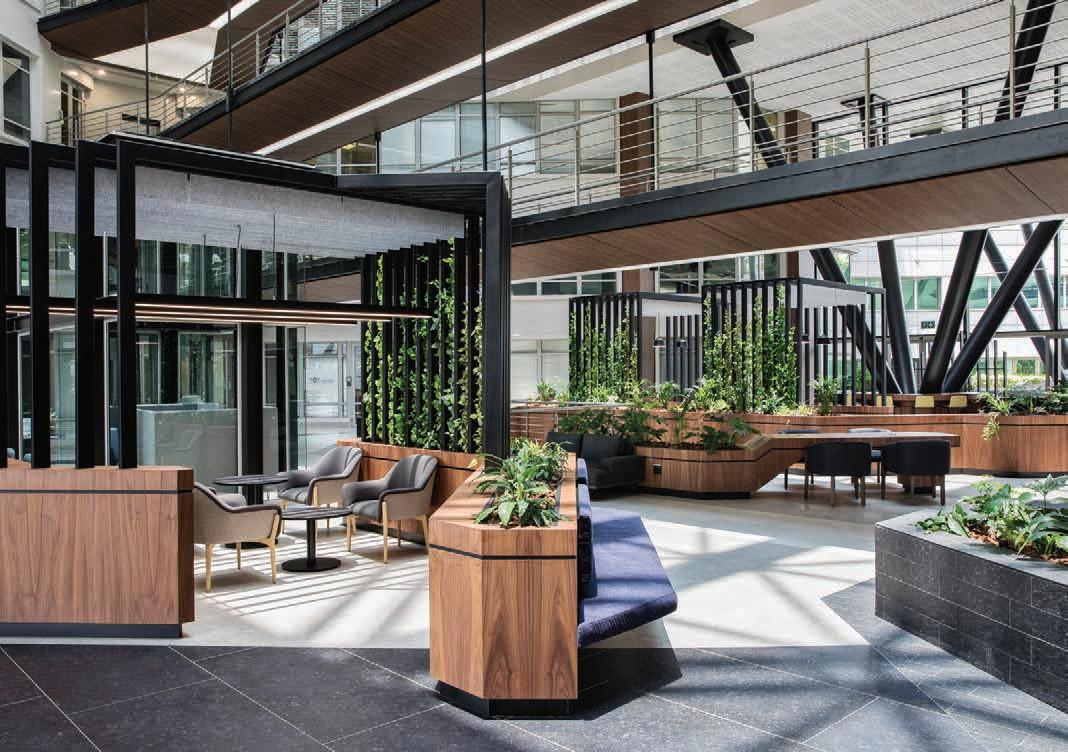
“CURRENT TRENDS IN BUILDING DESIGN ARE AN EVOLUTION OF TRENDS THAT HAVE STEADILY EMERGED OVER THE LAST DECADE.” – VUSUMUZI NONDOVusumuzi Nondo Claire D’Adorante Sharné Bloem Sandton Drive in Sandton upgrade





Asset management differs from property management as it focuses on maximising the asset and investment principles of the client.
By CARYN GOOTKINIn the broader sense, asset management means looking for opportunities in the client’s portfolio, finding ways to customise their buildings to unlock additional value, and advising on acquisition and disposal timeframes, says Andrew Dewey, MD of Swindon Property. “The basic asset management function looks at a building’s income and expenses stream and assesses whether the building is performing optimally and what can be done to make it a better-performing asset.”
There are several ways to increase a building’s income stream. Dewey gives a few examples: “Are there any common areas on the property that aren’t generating an income? Is there an opportunity to reduce the building’s operational expenses, for example, by hiring your own security or cleaning staff versus outsourcing? Is there a way to improve the rental you can charge for the building by, for example, upgrading the common areas, improving the parking supply, refurbishing the facade or adding additional bulk?”
The potential increase in rental income must be compared to the cost of doing the improvements.
“Asset management looks at the capital cost of renovating the building versus the increased return on investment once the improvements are done,” says Dewey.

In a property services company, brokers play a key role in providing asset management advice to clients. “The brokerage team can give input on current rentals per square metre achieved for similar properties in the market,” says Dewey. “They also come up with clever ways to improve the rental income based on what they see on the ground – things such as closing off parking, adding an extra floor or rooftop space, offering tenants signage, or putting a third-party sign on the building.”

Embracing technology is key to remaining effective and ef cient in the property management industry, and there are various software solutions that companies can use to stay on top of the game.
 By CARYN GOOTKIN
By CARYN GOOTKIN
One of the most important pieces of technology used at Swindon is a workflow system, which allows everybody allocated to that property login details and instant updating functionality, says Swindon Property MD Andrew Dewey.
“The property managers continuously update the workflow system to see where they are in various projects and processes – and the client has access to this. This eliminates continuous email correspondence and phone calls as the client can first log on to check the status of the various projects before contacting the property manager.”
The system also benefits the client because there is constant pressure on the property management team to complete their tasks and update the system. “The client has access to, for example, progress on building work or projects, status of arrears on tenant rentals, handover of new tenants,” explains Dewey. “Our clients can also access folders containing the various lease agreements and money management reports. The entire online
system is available as an app on their phones so they have all this information at their fingertips.”
Building maintenance software is also very useful to a property manager. “We have trialled this at Swindon, but have put it on hold for now,” says Dewey. “Essentially, it is a reporting system for maintenance issues that allows building managers to upload photos and receive quotes from service providers.”
Another useful software program for South African property managers is licensed by MRI Real Estate Software (formerly MDA Property Manager). “Most property managers use this system that allows clients to log in on the back-end to look at the rental stream on their buildings, cash flow, and other financial tools.”
At Growthpoint Properties, we are dedicated to creating sustained value by integrating environmental, social, and economic considerations into our business strategy. We recognise the increasing importance of a clearly defined Environmental, Social, and Governance (ESG) strategy (including measurable targets and results) to our investors, and we strive to meet their financial and non-financial performance expectations.
Our commitment to sustainability is reflected in our track record, having been included in the FTSE/ JSE Responsible Investment Index for 13 years and the FTSE4GOOD index for six years. We are also a founding member of the Green Building Council of South Africa and own the country’s largest portfolio of green-certified buildings. Additionally, through our carbon-neutral strategy, we aim to provide tangible benefits to our business and stakeholders with a focus on energy efficiency, off-site and on-site renewables, and carbon offsets.
However, our responsibilities extend well beyond the environment, and it’s vital that we make a positive contribution to the social and material well-being of individuals and communities. Our social investment activities focus on education, skills development, and enterprise and supplier development. Transformation is another critical component of our strategy, and we are proud to have achieved Level 1 B-BBEE Contributor certification according to Property Sector Codes – the first JSE-listed Real Estate Investment Trust (REIT) to do so.
sub-Saharan Africa where the direct-to-consumer delivery service is less advanced than that of other more developed economies, has caused a sudden impact on this market.”
The pandemic expedited a medium-term e-commerce growth forecast into just a few months. “While the sub-Saharan industrial and commercial spaces still represent strong investment figures and forecasted growth, there remains a migration of investors looking to purchase property offshore in the United Kingdom and Europe for the robust economies, historic growth, and currency hedge,” says Copley.
The pandemic changed how we work and interact with the outside world, causing some major shifts in commercial property markets, globally and at home.
The e-commerce boom has ignited the industrial property market – think warehouses and distribution centres – sometimes at the expense of the retail property sector. “A move towards the convenience of working and shopping from home has driven the demand for delivery of all goods and services from daily grocery shopping to luxury items and furniture and appliances,” says Megan Copley, director of offshore real
estate investment at Sable International. “With the increased demand for goods delivered to the home and expectations for speedy delivery, the consumer has driven a shake-up in how businesses organise their supply chains, which has, in turn, increased demand for warehousing in locations with proximity to city centres. This need for proximity, particularly important in
The United Kingdom (UK) has long held a superior position in the global hierarchy for property investment. “Historically, the UK has had a robust economy, strong currency, and high demand for tenancies in all three sectors: commercial, residential, and industrial,” says Sable International’s Megan Copley. “Demand from foreign investors has driven healthy increases in property prices, and the robust economy has meant that landlords have benefitted from annual rent rises and constant demand.”
Although the pandemic caused a wobble in the UK property market, things have recovered
GOOTKINquickly, even if the typography of the UK property market now looks a little different. “An increase in migration to cities other than London has driven the commercial demand in places such as Birmingham and Manchester, where businesses can secure office rentals at 30 per cent less than in London and landlords can capitalise on this new and growing demand,” says Copley. “The industrial sector is extremely buoyant with a reliance on e-commerce in UK cities and suburbs as more and more people rely on public transport to move themselves and delivery companies to move their goods. Commercial
A major issue now affecting office space globally is the work-from-home culture. “This is causing a decrease in demand for office space and an increase in competition for commercial property investors looking to incentivise tenants,” says Copley. “Tenants’ demands have increased, with landlords offering on-site baristas, facilities such as gyms and changing rooms, and an overall atmosphere for social interaction, for example, rooftop bars. While there is downward pressure on rents in this competitive climate, a major disruptor to the investment case of any commercial property at the moment will be a hike in rates when rents aren’t very competitive. So, the downturn in the commercial property market is evened out by the uptick in the industrial property space.”
premises have been transformed into industrial premises, and tenants have increased stock supplies to ward against any international delivery delays and keep up with the market demand and expectation of quick delivery times.”
The Polish investment market experienced a surge in growth during 2022, with a 30 per cent increase on the previous year’s figure. “One major contributor to this was Google’s purchase of The Warsaw Hub in central Warsaw,” says Copley. “While this has represented a significant upward trend in the Polish property market, there is a slowdown in construction now with investors taking a wait-and-see stance due to the war in Ukraine, a sharp decline in available construction material, and the rise in inflation. Provided supply of office space is restricted and tenant demands remain healthy, rentals may hold.”

“Tenants’ demands have INCREASED, with landlords offering on-site baristas, facilities such as gyms and changing rooms, and an overall atmosphere for social interaction, for example, rooftop bars.” – Megan CopleyWhat makes the United Kingdom and Poland attractive markets for South African commercial property developers? By CARYN

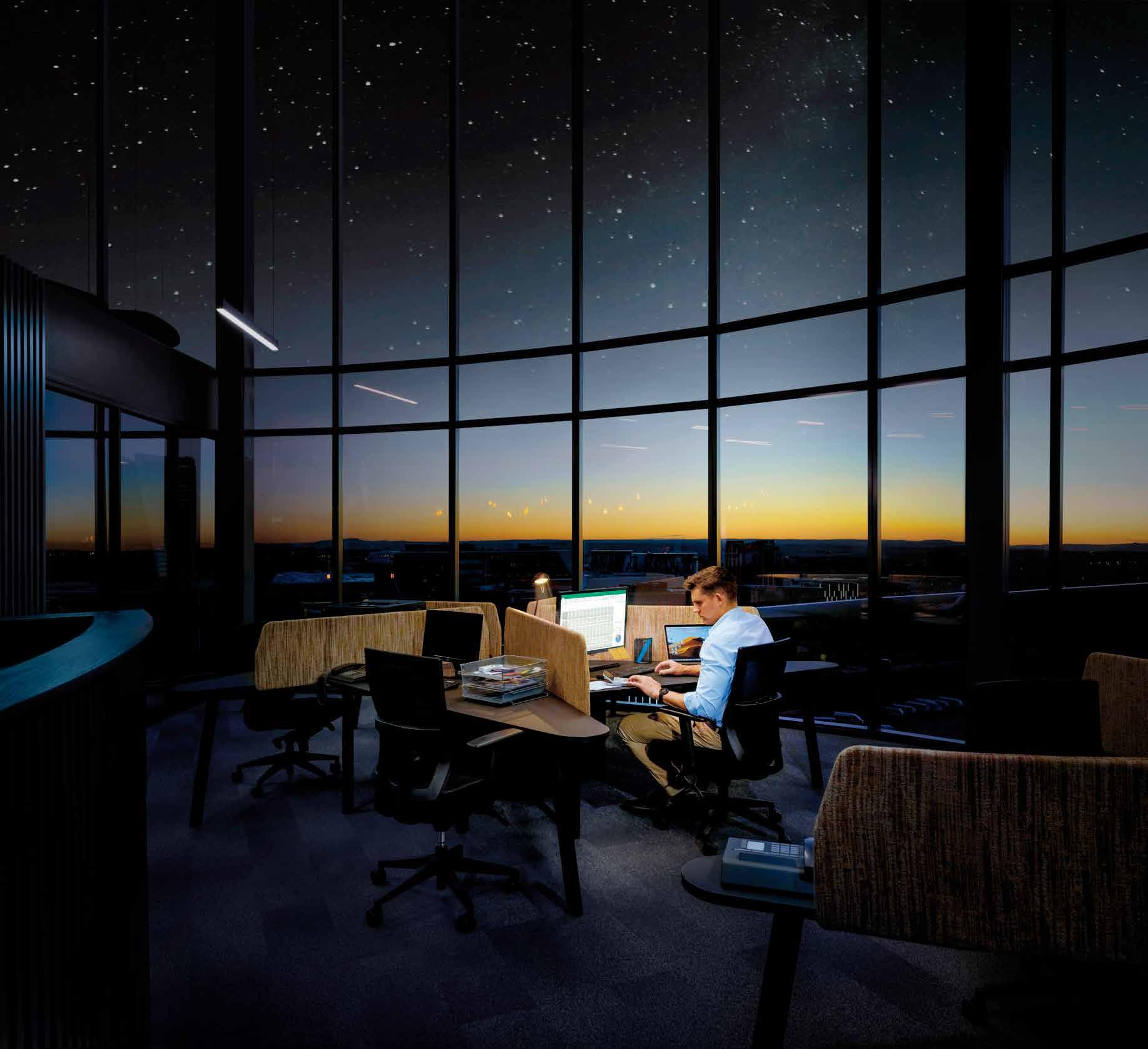

The property’s location also plays a pivotal role in the decision-making process. Financiers will consider aspects such as crime rate, the reliability of public services in the area, proximity to competitors, the condition of surrounding buildings, and whether any new developments are planned in the area. Entrepreneurs also need to ascertain whether the property complies with municipal regulations. This will influence the ability to raise finance and get the property properly insured.
Several advantages make owning commercial or business property a viable prospect for small businesses. These include asset appreciation, full control over interior design and renovations, security of tenure, and avoidance of above-inflation rent hikes. Small and medium enterprise (SME) owners need to be prepared when applying for finance for commercial property.
Acquiring funding for business property involves more rigorous vetting procedures and due diligence than applying for residential property. Small business owners need to ensure that their application inspires confidence in the financier, providing assurance that the purchase is financially feasible in terms of the asset’s future value of the asset and the track record of the business purchasing the business property. Financiers interrogate funding applications on three fronts:
• the state of the client s business;

• the viability of the transaction; and
• the value of the ro erty being ac uired. Research and preparation are key to successfully securing funding for commercial property. This relates to how supporting documents and information on the business are collated and presented, as well as aspects that position the property in a favourable light as a good investment.
Apart from the documents required for FICA purposes, SME financiers and other financial institutions will require a detailed business plan. This must be accompanied by a strong finance proposal backed by the business’s annual financial statements.
When reviewing funding applications, some of financiers’ considerations include the business’s credit history and, in many cases, the owner’s credit record.

Arguably, the most important aspect to be reviewed is the business’s cash flow management. As our quarterly SME Index continues to demonstrate, cash flow remains the number one challenge for South African SMEs. As such, applications need to shed light on whether consistent, adequate and sustainable cash flow will be maintained over the loan period, and how any potential shortfalls will be subsidised.
Financiers may require information on the history and current condition of the property, including aspects such as whether it has been well maintained and if any major structural issues have been identified. Required documentation will include the purchase agreement from the estate agent or current owners and any rental agreements that may apply to current or future tenants (in the case of plans to sublease).
Once the research and preparation are complete, SME owners are advised to review their options in terms of the interest rates and repayment options made available by banks, lenders and independent financiers.
Major factors to consider at this stage are lending rates, the term, the size of the bond, and any related fees, for example, administration, payments to attorneys for legal services and VAT. SME owners need to enquire if these costs will be incorporated into the loan amount or become payable separately.
The distinction between commercial and residential properties has a bearing on the loan term, given that business property is regarded as an income-generating asset. Generally, banks expect loans to be paid off faster than residential bonds.
Although SME owners may intuitively think of banks as their primary option for funding, established entrepreneurs should consider alternatives.
Our research and experience have shown us that in the initial stages of securing financing for commercial properties, one of the major pain points for small businesses is accumulating enough capital for a deposit. A deposit-free funding option may be more viable and accessible. In these cases, SME owners need to understand the conditions of a deposit-free loan and how it differs from traditional financing.








Outsourcing, shares why refreshing your warehouse management system before it becomes an e-commerce nightmare is critical

Achieving warehousing efficiency demands a quality inventory management system powered by automated software and executed by the right BPO partner. Such a provider will step in, conduct an in-depth needs analysis, identify gaps in performance, and provide solutions that assist e-commerce sellers in streamlining their operations. In outsourcing the warehousing management function to the specialists, e-commerce companies see a return in inventory management, storage space optimisation, and labour maximisation, which results in satisfied customers, reduced returns, and costs.
Relying on exhaustive data analysis gathered from time and motion studies during the needs assessment phase, a BPO provider will facilitate cost and performance efficiency throughout the entire warehousing process – from supplier ordering to packing and shipping. Efficiency is treated as a constantly moving target and is continually assessed by the BPO. Processes are tweaked, improved and optimised to ensure that the company’s warehousing function always maximises output and increases revenue while minimising input and costs.
When e-commerce businesses outgrow their warehouse management system, people and processes can no longer cope with the influx of orders. This leads to inefficiencies in space usage and product cataloguing, which causes delays in deliveries and unhappy customers. The solutions to this problem are to regularly assess warehouse management systems and processes to ensure they can keep up with business demands and hand over this enormous operational burden to a specialist business process outsourcing (BPO) partner.
What does an organised e-commerce warehouse look like? It’s not rows of meticulously managed shelves with similar items grouped alphabetically or by price. Rather, by using an automated inventory management system that runs on barcodes and barcode scanners, one of the world’s largest retailers operates its warehouses with a system called “chaotic storage”.
This is a dynamic form of warehousing in which products are stored wherever there is space. Not only does this mean that space is used as efficiently as possible, but it also leads to faster processing times. Quicker processing means orders are dispatched faster, which translates to satisfied customers.






As counterintuitive as chaotic storage might sound, many South African e-commerce companies will not be able to unlock their benefits if they continue to use manual processes (such as Excel spreadsheets) to record inventory movement. Even worse than manual processes is no warehouse management system, and the perils of an e-commerce company not moving to an automated system are numerous. Problems include order accuracy, increased storage and processing costs, and costly customer service failures.
With the right warehousing BPO partner in place, e-commerce companies will also unlock human resources flexibility. BPO providers handle the labour component of warehouse management and order fulfilment and can scale resources to meet sale-specific or seasonal fluctuating demands. A BPO provider can relieve clients of labour relations, occupational health, and safety compliance issues. Such benefits are often overlooked, but can have a massive impact on productivity.









By implementing an efficient warehousing management system and streamlining processes for an e-commerce business, a BPO provider will make it easier for e-commerce companies to keep their promises to customers. As a direct result of process outsourcing and optimising functionality within their supply chain, clients will benefit from ongoing efficient service delivery that generates a higher revenue value.
E-commerce businesses that neglect to relook at and refresh their warehouse management systems regularly are doing themselves a grave injustice that will cut into their bottom line in a way that can impact their ability to survive in an increasingly competitive space.
Logistics and warehousing space is in demand, particularly in the Western Cape, writes TREVOR
CRIGHTONTakealot has 45 000m2 and has leased two more properties with over 15 000m2 across the road, and Richmond Park has filled up over the last few months.” He says emerging companies such as WeBuyCars have changed the vehicle sales model and demanded more space –now requiring warehouses rather than 500m2 dealerships. “Warehousing is also cheaper to build and rent than retail space,” he says.
Cooper says that Cape Town still lags behind Gauteng and KwaZulu-Natal from a logistics point of view. “However, it offers more functional and supportive municipalities, which are attractive to investors.”
The logistics warehousing sector is experiencing high levels of activity and interest, driven by the rise of e-commerce and global stock shortages that have slanted provisioning locally.
Galetti Corporate Real Estate director Wesley Cowan says that while COVID-19 shutdowns slowed down progress and gave people pause for thought before committing to decisions, the continued growth of e-commerce has seen a rise in warehousing. “The sector – specifically in Cape Town – can’t keep up at the moment. Both speculative developments and spec builds are increasing, with the next 12 months showing great growth,” he says.
“One spec build in the Western Cape is still under construction and available. It’ll be finished in the second quarter of 2023 and I’m sure it’ll be leased by then.”
Jason Cooper, head of developments for Fortress Real Estate, says that while e-commerce continues to play a role in the growth the company is seeing in the industry, it’s not the only reason. “Most of the demand for space is from suppliers of the components of products sold through e-commerce channels.
Most of the occupants at our logistics parks are distributors of commodities such as sugar, paper, and polymers, and providers of healthcare and pharmaceutical products. We have also seen strong demand in the market from food and clothing retailers,” he says.
“We believe that businesses are holding onto more stock and want their products to be closer to consumers because of the significant strain put on supply chains due to COVID-19, trade disruptions, riots, and strikes, among others. Disruption in the world supply chain has focused attention firmly on local distribution and having products available to get to market more efficiently.”
Cowan says the lack of zoned industrial land in the Western Cape presents a challenge for logistics warehousing – and what is zoned is expensive, pushing up the total cost and base rental for any occupier. “There’s been such growth in Cape Town over the last few years for several reasons, so there are more people to service, and third-party logistics providers, retailers, and self-warehousing businesses have had to expand,” he says.
“Truworths has taken 4 000m2 in King Air Industria near Cape Town International Airport;
Fortress Real Estate is co-owner of Montague Park in Montague Gardens – a key centre for industrial property demand. The 60-hectare industrial park provides modern, attractive big-box warehousing on Cape Town’s main logistics routes. The scale of the park, and the developments within, make it a standout location for warehousing in Cape Town. On The Dot and Media24 have recently taken up 12 000m2 there, and Takealot has expanded its distribution centre by 20 000m2 to a total 50 000m2. “We are very fortunate to have premium parks such as Eastport Logistics Park (in Gauteng) and Clairwood Logistics Park (in KwaZulu-Natal) in our portfolio. They are attracting large blue-chip tenants to our parks,” says Cooper.
Cowan highlights Equites’ 17 000m2 distribution centre in Parow Industrial as a stellar spec build, which will be a Galetti Corporate Real Estate focus for the first quarter of 2023. “At nearly 3 000 hectares and zoned for industry, the property can cater to businesses looking for logistics warehousing space in the most central business location in Cape Town, feeding directly into most of the major roadways and transport links in the Cape Peninsula,” he says.


“THERE ARE MORE PEOPLE TO SERVICE, AND THIRD-PARTY LOGISTICS PROVIDERS, RETAILERS, AND SELF-WAREHOUSING BUSINESSES HAVE HAD TO EXPAND.” – WESLEY COWANGaletti’s nearly 3 000ha Parow View industrial property offers logistics warehousing space in the most central business location in Cape Town. Eastport Logistics Park

Mixed-use developments blend residential, commercial, retail and hospitality, providing residents with a convenient urban living experience. With a growing number of people wanting to live and work within close proximity where they can enjoy quality of life without long commutes and security concerns, mixed-use developments provide the solution.
Located on Cape Town’s Foreshore, Harbour Arch is a R16-billion mixed-use precinct that will comprise six towers, with the first due to open in May 2023. The vibrant pedestrian-friendly development will house restaurants, cocktail bars, shops, hotels, banking facilities, medical services, and health clubs.
The Foreshore Place, a 34-storey iconic landmark in Cape Town’s financial district, has been around since the 1900s. Situated on the corner of Adderley Street, Riebeek Street and St George’s Mall, it is the fourth tallest building in Cape Town and was previously known as the ABSA building. In the last four years, it has been refurbished to include retail, residential units, a hotel, offices, and co-working spaces. It has 190 residential units mixed between studio, one-bedroom, and two-bedroom apartments with Scandanavian-inspired interiors. One of the few glass buildings in the city, The Foreshore Place is aesthetically pleasing with black and gold detail.

“Its location is one of the drawcards offering panoramic views of the harbour and the ocean. And, it’s very close to CBD public transport routes,” says Itai Ilouze, head of broking at Galetti Corporate Real Estate. The building is just a short walk from the V&A Waterfront and other attractions such as the Artscape Theatre and the Cape Town International Convention Centre. Ilouze adds that when designing a mixed-use development, it’s important to ensure it offers a variety of things and caters to all demographics.
The 23-floor Harbour Arch Tower 1 has 560 residential apartments, including 82 rental units, 158 studio apartments, 203 one-bedroom apartments, 58 two-bedroom apartments, and 59 three-bedroom apartments. It features retail space on the ground level reserved for exclusive motor dealerships and coffee shops and additional retail space on the eighth floor, which will include restaurants with indoor and outdoor seating.
“Mixed-use developments are urban villages – a place where you can live, work, and play – and an attractive solution to the housing shortage,” says Nicholas Stopforth, managing director of Amdec Properties. “Convenience and quality of life are the top two factors developers must consider when designing one – they need to strike a balance between urban convenience and the tranquillity of nature.” The large-scale development, across 200 000m 2, is due to be completed in 2030.
Steyn City has a range of homes, apartments and clusters that can accommodate any homeowner, whether for a lock-up-and-go lifestyle or starting a family. Sprawling over 2 000 acres on the edge of Sandton, the mixed-use development also has AAA-graded offices and a school for Grade 000 to matric learners. Facilities include an 18-hole golf course, an equestrian centre with a clubhouse, eateries and coffee shops, resort pools, tennis courts, a 45km promenade for running, a gym, and fishing dams.


Steyn City was the vision of Douw Steyn and property developer Giuseppe Plumari, who wanted to create a community rooted in old-fashioned values such as neighbourliness and family. “The development’s design is about creating an outdoor-oriented lifestyle rooted in wellness. This has been made possible by offering facilities that get people outside, spending time together and doing things they love, rather than sitting in front of their screens,” explains Zoe van Onselen, head of marketing at Steyn Properties.
The people-centric design of the development makes it unique. “Generally, people spend most of their time in their cars with few opportunities for interaction. In contrast, Steyn City encourages these interactions because pathways and greenbelts take precedence over roads,” adds van Onselen. Vehicle use in the development is almost incidental as residents can reach facilities on foot, bicycle or golf cart.
“MIXED-USE DEVELOPMENTS ARE URBAN VILLAGES – A PLACE WHERE YOU CAN LIVE, WORK, AND PLAY – AND AN ATTRACTIVE SOLUTION TO THE HOUSING SHORTAGE.” – NICHOLAS STOPFORTHThe Foreshore Place
The “apartment hotel” concept isn’t new – but it’s being used in interesting new ways by post-pandemic travellers.
“There’s a definite trend towards bleisure – people are adding vacation days to business trips and often bringing in their families for some quality time, which comes with different demands,” says Home Suite Hotels CEO Jonathon Meyer. “The mixed-use building concept with a hotel-type offering appeals because it blends the necessary facilities under one roof, giving people plenty of choices.”
BlackBrick founder Moritz Wellensiek is looking to develop a network of mixed-use hotel apartment buildings and offer owners a club membership that will allow them to live in both Johannesburg and Cape Town – and the rest of the continent and the world – for a single fee. “Our first property in Sandton is doing well, and we’re about to open our second, which will give us 500 units in the heart of the CBD. We also have a building on the Foreshore in Cape Town and will complete more in Bedfordview, Rosebank, Gardens and Umhlanga Ridge to
bring our offering to seven sites, with other deals around the country and across Africa to follow,” he says.
Wellensiek says the BlackBrick concept appeals to investors and travellers because they appreciate the flexible living opportunities and the programmed spaces with scheduled talks, rooftop events, movie nights and restaurants that bring the community together outside of the communal workspaces and stylish rooms.
Speaking of Home Suite Hotels’ Station House development in Fresnaye, Meyer says the thought that went into the design and amenities caters to both hotel visitors and residents. “At Station House, 44 of the 200 rooms are currently in the hotel pool, and more owners are looking at adding theirs,” he says. “The majority of investors are going this route because the yield is better and the solution is completely managed from our side, so they can simply stay in their own room for a certain number of nights each year and have us manage the rest of the schedule.” The
hotel portion is exclusively managed by Home Suite Hotels, with residents unable to rent out their rooms on other platforms, to allow for the curation of visitors, numbers and stay durations.
Wellensiek says most BlackBrick buyers are also using the platform as an investment as the team’s hotel management aspect offers a rare turnkey solution with furniture and tech packs. “We manage the hotel pool and pay owners a monthly distribution, which has outperformed monthly projections so far during the challenges of COVID-19, so we’re expecting even bigger things in 2023.”
The future of work, in most industries, looks likely to involve a combination of in-of ce and work-from-home. This is driving the growth of exible and alternative spaces.
Of ce layout is changing as the need for of ce stations for all employees recedes and the need for meeting and collaboration spaces increases. Repurposing existing of ce space and updating building layouts are now focus points for many real estate companies and investors.
In general terms, the focus on exibility will be even stronger for new constructions. One of the sectors that already have a head start on this trend is the hotel industry, where the aparthotel concept is currently one of the most exciting and fastest-growing segments of this market.
Globally, new brands are being launched and established operators are converting their products and business models from traditional hotels to serviced apartments, often with on-site amenities.


We’re seeing far more global workforce mobility, due in part to greater connectivity, but also the spike in remote and exitime working since the pandemic. In South Africa, semigration is also a driver.
A new trend, bleisure, is booming too. It’s estimated that 66 per cent of travellers work while on holiday, so more trips mix business travel with leisure activities.
And it’s simply not practical or convenient to stay in hotels on an ongoing basis as most people want to be able to prepare basic meals and not be con ned to just one small room.
The growth of these trends is borne out by statistics in a 2020 report by The Apartment Service Worldwide, which found that growth in extended-stay and serviced-apartment accommodation is accelerating, with a 24 per cent increase in capacity between 2018 and 2020 compared to 10.5 per cent growth in the preceding two-year period.
This is further corroborated by recent research undertaken by commercial property consultancy Lambert Smith Hampton (LSH), which says that serviced apartments and aparthotels are the fastest-growing segments of the United Kingdom’s hospitality market.
However, the key problem for future development in major metros is the dearth of available land or suitable sites, especially in prime areas.
In Johannesburg, the main commercial hubs in areas such as Melrose, Rosebank and Hyde Park are already fully developed, and developers are now repurposing older buildings to meet the shifting demands.
Internationally, hotel real estate investment trusts (REITS) have proven to be a popular way to own and invest in hospitality assets. The 14 largest United States’ hotel REITs have a combined value of around $55-billion.
How we work and live has been changing and, accelerated by the disruption of the pandemic, it’s now very different than it was a decade ago, writes COBUS ODENDAAL, CEO of Lew Geffen Sotheby’s International Realty in Johannesburg and Randburg
Not all apartment hotel concepts are created equal, writes TREVOR CRIGHTONStation House lounge Sandton Studio with balcony
GARETH
Phase 1 of the R1.3-billion award-winning Oceans Umhlanga Mall in KwaZulu-Natal (KZN) officially opened its doors to shoppers in November 2022. Co-developed by well-known KZN businessmen Vivan Reddy and Rob Alexander, the 36 000m2 shopping mall is part of the R4.3-billion mixed-use Oceans Umhlanga Development.
Project architect Nick Proome, director of Elphick Proome Architecture, says the new site is bounded by Lighthouse Road, as the main entrance to Umhlanga, to the south, Ridge Road to the west, Lagoon Drive to the east, and Flamingo Lane to the north.

“The planning approval was to create a plinth comprising two retail levels and four parking levels that would make up the 12m-level difference between Ridge Road and Lagoon Drive. Three freestanding towers would be developed above this plinth. These are the hotel and hotel apartments to the south, and two residential towers spaced over the development to the north,” he says.

Along with Woolworths, Shoprite Checkers is one of the anchor tenants with its flagship Checkers FreshX. The mall will ultimately feature a further 120 stores, feted to rival the V&A Waterfront and Sandton, including a ‘Platinum Walk’.
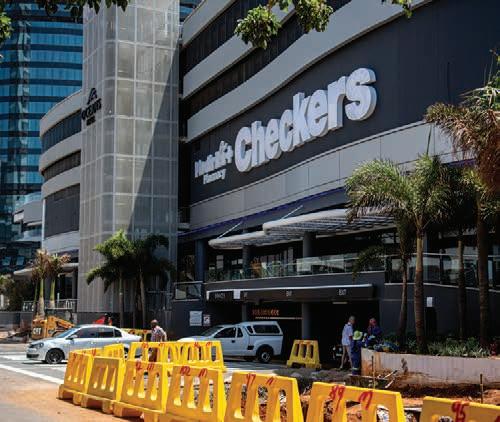
Chief operating officer for Shoprite Checkers Willem Hunlun, expands on the new concept it has introduced: “The Checkers FreshX store concept targets the more affluent consumer. It provides customers with a superior retail experience, introducing new in-store services and greater convenience, and it prioritises convenient, quality, fresh and prepared products.
“Checkers Oceans Mall offers customers a premium shopping experience with exclusive private label brands and world-class features, including a wine cellar, coffee station, sushi bar, pizza bar, and an in-store Kauai. A recent innovation, a standalone Outdoor Store stocked with camping and braai
accessories and high-tech gadgets for nature enthusiasts, is part of the group of five concept stores we have opened.”
Hunlun says that the group’s internal design team works closely with local designers TDC&Co, and Argentinian-based International Merchandising Solutions SA (IMS) to benchmark and develop new store design concepts and innovations.
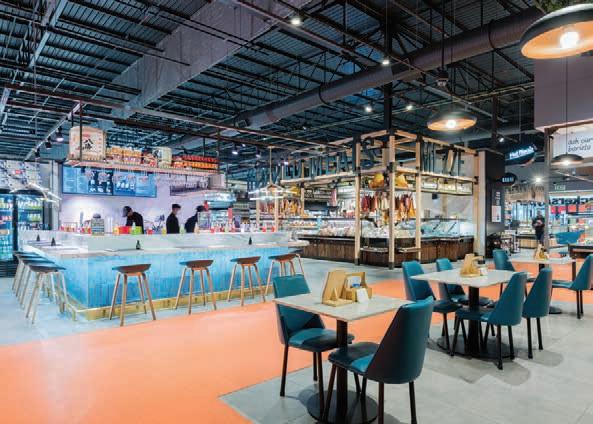
Jorge Barisonzi, CEO of IMS, says that when developing the FreshX stores, design and customer experience were a must. “The butcher shop features a slot-by-slot butcher line-up, including a braai cart for in-store tastings, sosaties and gourmet cuts. And a 360˚ island allows customers to navigate the department and discover the full spec of product ranges.
“Surprising and encouraging customers for longer periods inside the store is a key activity when designing positive experimental stores. Facilities – more recently, such as an e-sommelier in the wine shop to assist customers with pairing wines and food – are essentials to educate and inspire customers to test new foods.”
Bertus Bouwer, a director at SLT Architects in Cape Town, whose company has been involved in the design of new retail malls and major renovation projects in South Africa and throughout Africa, says that with rapidly changing trends, designers need to be up to date and lead the way with a combination of ideas, approaches, and techniques.
“We believe the larger retail centres are evolving into a safe destination to visit and play rather than just a ‘let’s go shopping’. To draw feet, retailers are focusing on in-store and mall experiences to encourage longer time spent on the premises. Recent trends allow cleverly designed spaces where patrons can share their time at the mall via social media. This also provides free advertising for the tenants.
“There is a growing need for smaller convenience retail centres. Another concept, the strip mall, is a perfect addition to suburban-focused developments. ‘Convenience and practical’ are the dominant words used at the inception design stage of such a project. A smaller anchor food tenant, a pharmacy, a popular franchise restaurant chain, liquor store, butcher, hardware store and even a drive-thru are very popular.”
GRIFFITHS reports on how the retail sector is expanding its value proposition to customers via innovations post-pandemic
“SURPRISING AND ENCOURAGING CUSTOMERS FOR LONGER PERIODS INSIDE THE STORE IS A KEY ACTIVITY WHEN DESIGNING POSITIVE EXPERIMENTAL STORES.” – JORGE BARISONZIThe Checkers store in the Oceans Umhlanga Development. Checkers Hyper Fairbridge Mall Sitari Village Shopping Centre Harbour Arch Images: Shoprite Checkers, IMS SA, SLT Architects
In 2018, the Department of Higher Education and Training acknowledged a shortage of student accommodation and said that 300 000 beds were required to address the shortfall over eight years across the country. But this would not be a cheap affair; the department estimated it would need R50-billion to meet this demand. While universities across the country search for ways to meet the rising demand for student housing, affordability and innovation are key, with some experts saying innovation can produce affordable accommodation.
The University of Fort Hare’s student village, boasting 2 047 beds, was the first project developed in an effort to provide more affordable student housing as part of the Department of Higher Education’s Student Housing Infrastructure Programme. Completed in 2021, the student village has 17 buildings with 125 beds each, consisting of single and double rooms, rooms for students with disabilities, and communal kitchens and bathrooms. The village has a student centre, entertainment area, restaurants and shops.
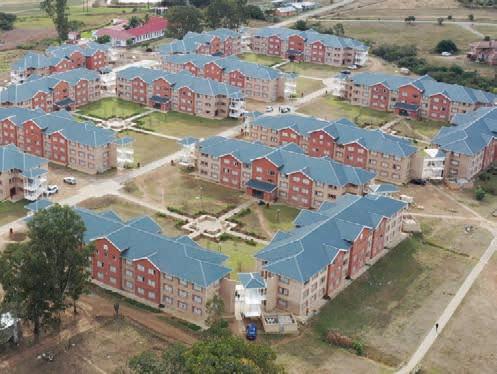
“We’ve tried to design with creating communities as a strong element so that the students feel like they’re at home and belong,” explains STAG African CEO John Schooling. “If the students are emotionally and spiritually happy, they’re more likely to succeed.” Schooling cites five design principles crucial to building student housing in the 21st century: • community;
• sustainability;
• innovation; • technology; and • flexibility.
In the South African context, it also includes social, economic, and political transformation. STAG, as a 50 per cent black-women-owned company, has ensured that it’s compliant.

“It’s also important that the buildings are cost-effective and affordable,” says Schooling.
South Point CEO Ndumiso Davidson agrees that innovation, evolution and affordability are key in student housing. “Student housing is no longer simply providing a key to a room with a bed,” says Davidson. “The full student experience in a well-considered nurturing academic and social environment is paramount.”
Established in 2003 in Braamfontein, South Point, which started with just five buildings, was an alternative to exploitative landlords who provided poorly maintained and expensive off-campus accommodation.

The Braamfontein building has 500 units accommodating over 1 000 senior and postgraduate students. It has since grown tenfold, housing more than 13 000 students nationally. The bulk of South Point’s properties are in city centres, transforming places that were previously no-go zones, such as Braamfontein, into hip mixed-use and student-friendly developments surrounded by amenities.

Design-wise, South Point spaces are inspirational and aspirational, with well-considered public spaces such as lobbies, study spaces, dwell areas, courtyards, and roof gardens. Technology, driven by high-speed Wi-Fi, also shapes ongoing change in the physical environment, says Davidson. “When we first started, TV rooms were an important part of our
“TECHNOLOGY, DRIVEN BY HIGH-SPEED WI-FI, ALSO SHAPES ONGOING CHANGE IN THE PHYSICAL ENVIRONMENT.”
residential infrastructure. Now, the ‘TVs’ are in students’ phones, which they watch in their rooms.”
Eris Property Group development manager Dacre Hattingh agrees that free Wi-Fi is something students cherish. In one of its student accommodations, Units on Park in Hatfield, students came back during hard lockdown predominantly to use the free Wi-Fi and to access free water and electricity. Eris’ latest development is the R1.5-billion redevelopment of the Cape Town Station Forecourt, comprising a retail centre and a 3 085-bed student accommodation, Cape Station, which will cater to CPUT students.
The development will be the biggest student accommodation in Africa and is expected to be completed in the next 10 months. It’s a 20-storey green building that uses LED lighting and low-flow toilets and showers. The student housing ranges from single-bedroom to four-bedroom apartments with communal kitchens and bathrooms. The building also has game rooms, a gym, a cinema, sports courts, and 7 000m2 of retail on the ground floor.
“Being on top of a shopping centre covers a lot of bases for students and also provides them with a source of income as they can work at the restaurants and bars,” says Hattingh.
TIISETSO TLELIMA looks at sustainable and innovative developments in student housing
– NDUMISO DAVIDSONSouth Point Units on Park, Hatfield The University of Fort Hare’s Alice Student Village. South Point
My Student House works a little differently from normal rental agencies, as we structured our services to provide student accommodation landlords with the option of having a pleasant, passive income experience, while still experiencing the great returns that can be achieved with student accommodation.

We manage your students, house rules enforcement, supervision and the wellbeing of students.
We manage your property, accreditation assistance, maintenance internet, annual work and emergencies.



We do student placements, collect your rent from students and universities, handle evictions and organise legal handovers.


